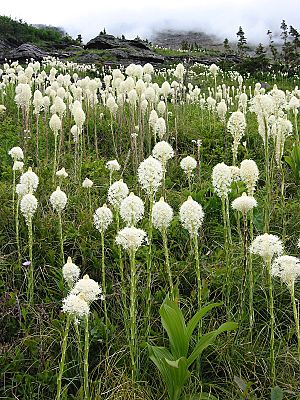Xerophyllum tenax facts for kids
Bear grass, also known as Xerophyllum tenax, is a cool plant found in North America. It's part of the corn lily family. People also call it squaw grass, soap grass, quip-quip, or Indian basket grass.
Quick facts for kids Xerophyllum tenax |
|
|---|---|
 |
|
| Glacier National Park, Montana | |
| Scientific classification | |
| Genus: |
Xerophyllum (plant)
|
| Species: |
tenax
|
| Synonyms | |
|
|
Contents
How Bear Grass Grows
Bear grass plants can grow quite tall, from about 15 centimeters (6 inches) to 150 centimeters (almost 5 feet) high! They grow in groups, with their long leaves wrapped around a small stem close to the ground.
The leaves are usually a dull olive green color. They can be 30 to 100 centimeters (1 to 3 feet) long and have tiny teeth along their edges.
Flowers and Seeds
When it's time to bloom, a tall stalk shoots up from the plant's base. This stalk has many white flowers that are slightly fragrant. The flowers are packed tightly together at the top, looking like a club.
After blooming, the plant makes small, tan seeds. These seeds need to be cold for 12 to 16 weeks before they can sprout. Bear grass plants usually only bloom every five to seven years.
Where Bear Grass Lives
You can find bear grass mostly in western North America. It grows from British Columbia in Canada, south to California, and east to Wyoming. It likes to live in high mountain meadows and coastal areas.
It's very common in places like the Olympic Peninsula, the Cascade Range, the northern Sierra Nevada, and the Rocky Mountains.
Bear Grass and Wildfires
Bear grass is an important part of how nature works in areas where wildfires happen. It has special underground stems called rhizomes. These rhizomes can survive fires that clear away dead plants on the surface.
Because of this, bear grass often thrives after a fire. It's usually one of the first plants to grow back in a burned area.
Animals and Bear Grass
Different animals enjoy eating bear grass. Deer and elk munch on the flowers and other parts of the plant. Bears like to eat the softer bases of the leaves.
Uses of Bear Grass
Bear grass has strong, fibrous leaves. When these leaves dry, they turn from green to white. They are tough, last a long time, and can be easily dyed. People can weave them into tight, waterproof baskets.
Traditional Uses
Native American people have used bear grass for a very long time. They weave its leaves into beautiful baskets.
Historically, they also cooked and ate the rootstock of the plant. The pods were also good to eat when cooked. Some Native American groups, like the Hupa people, use bear grass to create special border patterns in their baskets. They also braid dried leaves to decorate traditional buckskin dresses and jewelry.
Images for kids
-
Bear grass in Mount Rainier National Park, Washington state
See also
 In Spanish: Xerophyllum tenax para niños
In Spanish: Xerophyllum tenax para niños


